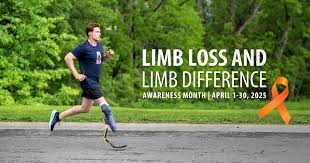April: Limb Loss and Limb Difference Awareness Month – A Celebration of Strength and Resilience
April is Limb Loss and Limb Difference Awareness Month (LLLDAM), a time dedicated to honoring the millions of people who live with limb loss or limb difference. This month is about advocacy, awareness, and empowerment—while also adding a bit of humor, because, let’s face it, the best way to navigate life’s challenges is with a good laugh.
By the Numbers: Limb Loss in North America
Limb loss is far more common than many people realize. In the U.S., approximately 5.6 million people live with limb loss or limb difference. Around 465,000 amputations occur each year, primarily due to vascular disease (such as diabetes and peripheral artery disease), trauma, and cancer. By 2050, the number of Americans living with limb loss is expected to rise due to aging and chronic conditions (Adaptive Amputees).
In Canada, although statistics are less centralized, an estimated 200,000 people live with limb loss, with roughly 4,000 amputations occurring annually. Like in the U.S., diabetes and vascular diseases are leading causes (Amputee Coalition).
One surprising statistic? The most common amputation is actually toes, proving that even the smallest parts of us can have a big impact when they’re gone.
Why Amputations Happen
While Hollywood loves to depict amputees as war heroes or action survivors (cue every war movie ever), reality is a little less dramatic. Here’s the breakdown:
57% of amputations are linked to diabetes—poor circulation leads to infections, and sometimes, amputation is the only option.
40% are caused by vascular disease, which reduces blood flow, leading to tissue death.
43% of amputations result from infections—many of which could be prevented with early medical intervention.
Trauma accounts for 45% of limb loss—from car accidents, workplace injuries, and military service.
Less than 2% are due to cancer—such as bone tumors requiring amputation (Hanger Clinic).
Beyond the Loss: The Journey of Resilience
The road after limb loss isn’t just about adjusting physically; it’s about navigating the emotional and financial impact as well. About 36% of amputees experience depression, and lifetime healthcare costs for those with limb loss are approximately $150,000 higher than those without. However, prosthetics and rehabilitation can reduce overall healthcare costs by up to $100,000 when received early (Hanger Clinic).
The good news? 92% of amputees report that peer support improves their outlook, and with advancements in prosthetics, many are leading active, fulfilling lives. Organizations like the Amputee Coalition provide vital resources, from peer mentoring to advocacy (Amputee Coalition).
Famous Amputees Who Inspire
Many well-known figures have turned their limb loss into a symbol of strength:
Terry Fox (Canada’s beloved marathon runner) – After losing his leg to cancer, he started the Marathon of Hope, raising millions for cancer research.
Bethany Hamilton (Pro surfer) – Lost her arm to a shark attack but continued to dominate in professional surfing.
Jim Abbott (MLB pitcher) – Born without a right hand, but that didn’t stop him from throwing a no-hitter for the Yankees.
Zac Vawter – The first person to use a mind-controlled bionic leg. Move over, Iron Man!
A Month to Celebrate Strength and Community
April isn’t just about awareness; it’s about celebrating the resilience of the limb loss community. Events like Show Your Mettle Day (where amputees proudly show off their prosthetics) and Wear Orange Wednesdays help bring visibility and solidarity to the cause
The Limb Preservation Foundation holds a symposium every year towards the end of April to allow amputees, doctors, prosthetic and orthotics companies, etc. to come together. The symposium allows everyone to network and stay in the know of what's new for people living with limb loss or limb difference.
The message of Limb Loss and Limb Difference Awareness Month is clear: losing a limb doesn’t mean losing your sense of humor, ambition, or ability to thrive. So, this April, take a moment to recognize the strength of those living with limb difference, and if you’re part of this incredible community—keep shining, keep laughing, and keep proving that nothing can hold you back.

